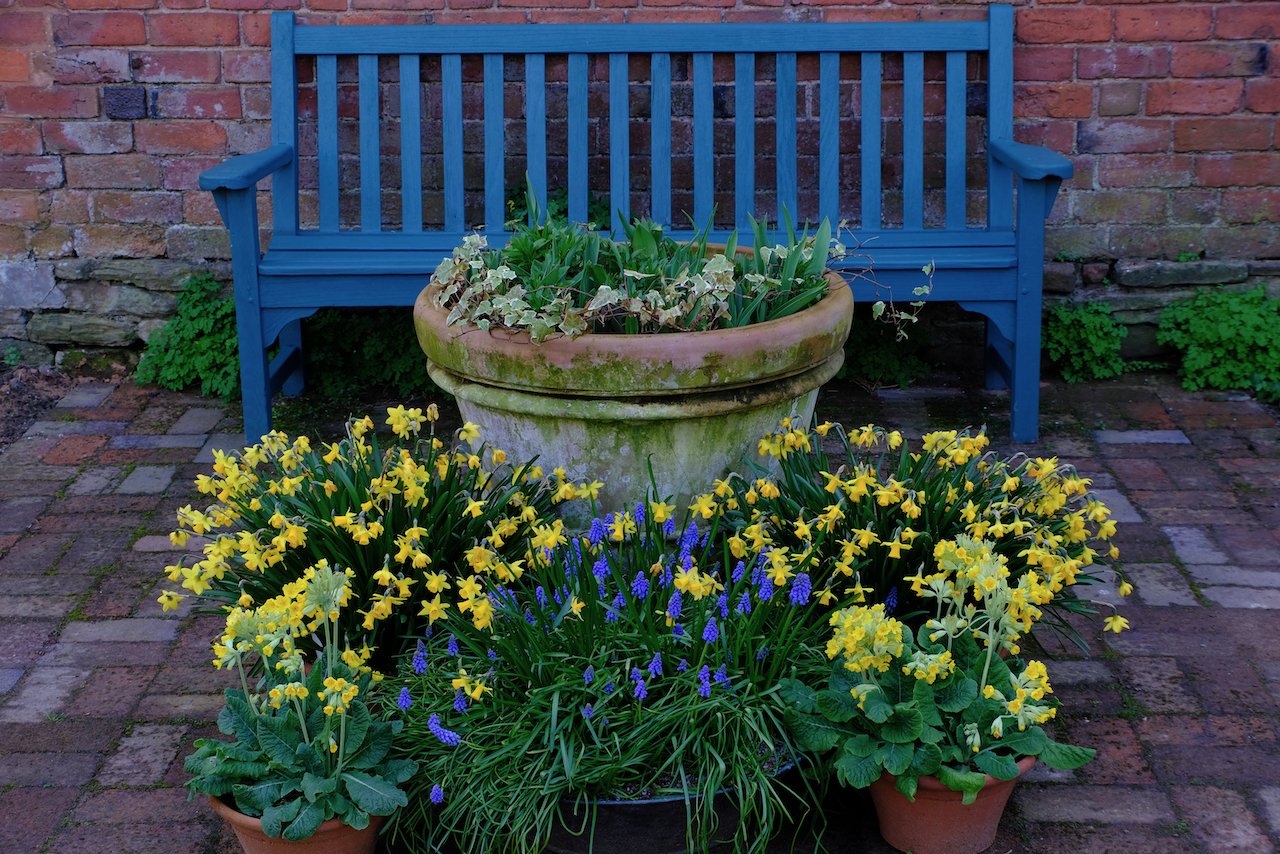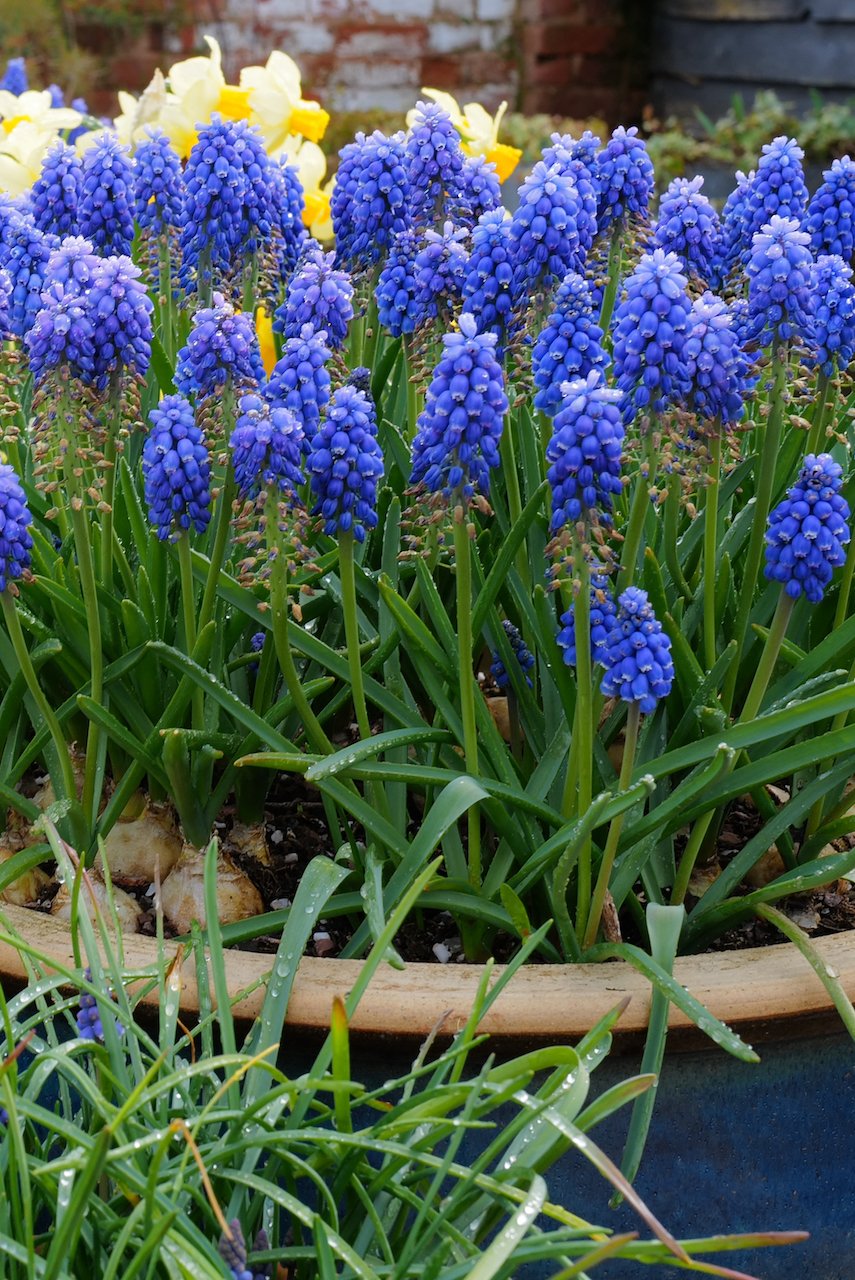March 2024
February in my garden - and most gardens across the UK - was unrelentingly and miserably wet. When it was not actually raining it was muddy, with constant flooding. We were forced to dig up the whole of our Long Walk and lay perforated drainage pipes to try and take away and spread some of the rainwater from our buildings as other parts of the garden were literally saturated and the fresh water had nowhere to go.
This is a direct effect of climate change - it was also extraordinarily mild - and clearly something that we are going to have to live with. In practise this opens a whole new set of horticultural situations to deal with.
The newest is that we are now going to have to encourage plants in our gardens that can cope with both extreme wet and extreme drought. Until now we always considered either one of those two positions but never both.
We also have to think how we can store this excess winter water in meaningful quantities for use in dry summers. The occasional water-butt is not sufficient.
The combination of wet and warmth in winter is also the perfect environment for fungi to flourish. This need not be a complete disaster - we need fungi for our gardens to thrive - but there are also fungal diseases, such as box blight, which have become unmanageable and I now believe clipped box to be not viable in my own garden as the fungus enters through the wounds caused by clipping. This dramatically changes the way my - and so many gardens - look.
But change is inherent in nature and all gardens.
And whatever the weather brings, March changes from day to day, even hour to hour. We often have snow, frost, wind, rain and warm sunshine and always have daffodils, blossom, fritillaries, the hedges breaking into leaf and the grass growing.
It is Spring!
THE GARDENING BOOK
…is the best guide you can have for creating exactly the kind of garden, big or small, that you really want to suit your lifestyle. Available here.
MARCH JOBS
Any herbaceous plant can be divided this month. Dig the whole plant up and discard the centre section to the compost heap, replanting the more vigorous outside parts of the plants in groups which will grow together to make one large plant. It is worth doing this to all herbaceous perennials every three to five years.
If your soil is ready then March is a good time to plant and move things around. But ‘ready’ means, above all, warm enough. The only way to know this is by touch. Pick up a handful of earth. If it feels cold and clammy to the skin then seeds will not germinate and roots will not grow. If it feels warm, holds together when squeezed and yet can easily be crumbled then it is ideal.
LAWNS
The grass will need mowing in March but do not cut it too short. Just give it a light trim for the rest of this month. This will encourage good root growth and as a result the grass will be a lot healthier and better able to resist summer drought.
To get a ‘good’ lawn you have to think positively. Put your efforts into healthy grass rather than fighting perceived ‘problems’ like daisies, moss, ants, worm-casts, moles, plantains, dandelions and fairy rings. Nine times out of ten if the grass is healthy then everything else will look after itself.
The best grass likes very well drained soil. Moss, for example, is always a symptom of poor drainage, made worse by shade. Unfortunately even the best prepared soil becomes compacted by matted roots, rain and, especially, normal family use. The answer is to work on it at least once a year by sticking a fork in the ground and wiggling it about and repeating the process every 6 inches or so.
Then mix up equal portions of sieved topsoil, sharp sand and sieved leaf mould or compost. If you do not have these things to hand then just sharp or silver sand will do the job. Spread it across the area you have pricked and brush it in with a stiff broom, filling the holes with the mixture. This will help drainage and feed the grass.
It is also worth giving the lawn a good scratch with a wire rake. This will get at all the overwintering thatch and moss, and let light and water get to the soil and to the roots of the grass. Put the debris on the compost and then mow. It will look a little bald for a week or so but will grow back thicker than ever.
BULBS
Do NOT cut back, tie or tidy the leaves of any bulbs but let them die back naturally as next year’s flower is being created by the photosynthesis of the foliage. Leave them until the last trace of green has gone - which will be at least June - and then cut back the dead foliage.
PRUNING
The first half of March is the best time to prune any shrubs and climbers that will flower on new growth and in particular late flowering clematis, roses and buddleia. I like to do this when I start to see new shoots appearing but resist the temptation to do so if there is a mild February as the subsequent regrowth can be nipped back by a late frost.
Shrubs such as Cornus, Willow and Sambucus can also be cut back hard to encourage fresh shoots whose bark will glow with extra bright colour next winter.
I know that pruning can be the cause of some anxiety but there is only one rule to follow which is always cut back to something, be it a side shoot or leaf bud. Other than that do not worry unduly about outward facing buds or any such finessing.
The reason for pruning is to encourage vigorous new growth that will in turn produce lots of flowers and, in climbers such as the viticella group clematis, to stop the flowers being produced ever higher and higher up the plant with correspondingly bare lower portion.
ORNAMENTAL GRASSES
Deciduous grasses like miscanthus, calamagrostis and deschampsia should all be cut back hard to the ground before the new green shoots start to grow too long.
Evergreen grasses like the Stipa and cortaderia families should not be cut back. However comb through each plant with a rake or your hands (I advise wearing stout gloves as grasses can be very sharp) pulling out all dead growth. The old dead growth can be shredded and composted.
When you have finished clearing and cutting back, give the ground around the grasses a thick mulch with a low-fertility material – i.e not garden compost or manure. I use a pine bark mulch.
However, do not divide or move any grasses at this time of year. They must be growing strongly to have the best chance of surviving so wait until late May or even early June.
PLANTING
Although March is often too early to plant out tender young seedlings it is a very good time to plant woody shrubs so that the roots can start to grow before the demands of new foliage become too stressful and this is especially true of any bare-root plants.
Because these are plants that will hopefully remain in the garden for years to come it is worth taking some trouble with their planting. Make sure that every scrap of perennial weeds are removed and dig a wide but shallow hole about 9 inches deep. Loosen the subsoil but do not add any compost or soil improver.
I like to dust myccorrhizae over the roots to help establishment and plant slightly proud of the soil level but firming the roots well to form a slight cone.
Water generously before mulching thickly with good compost.
PLANTING DAHLIA TUBERS IN POTS
Once we go into March I take my dahlias out of their winter storage, go through them to check that there are no rotten or shrivelled tubers and pot them all up so that they can begin to grow with some protection for the next couple of months before planting them out already growing strongly once the risk of frost has passed - which at Longmeadow is usually mid May.
I pot them so the tubers are just covered, using a standard peat-free compost mix, doubling up if necessary on smaller tubers of the same variety to make for larger plants.
Having given them a good soak these then go into cold frames or the greenhouse, but will spend a couple of weeks in May hardening off before their final planting in borders or more decorative terracotta pots.
ALLOTMENT / VEG GARDEN
Sow seeds under cover such as cabbage, lettuce, celery, beetroot and tomatoes. Do not sow any seeds outside if the ground feels cold to touch. If warm and dry enough, sow broad beans, beetroot, rocket, spinach, mizuna, parsnips, radish and winter lettuce.
Planting Shallots - I think shallots are even more essential to the cook than onions. They have a sweeter taste, tend to be easier to grow and store incredibly well, lasting a year or more in a cool, dark well ventilated place. Unlike onion sets which swell to become one full-sized onion, shallot sets multiply to form a clump that can contain as many as a dozen individual bulbs.
Plant them directly outside, 9 inches apart in rows about a foot apart. This makes them easy to hoe. Do not completely bury them but leave the shoulder of the bulb and tips clear of the soil.
I suggest covering them with fleece for the first few weeks so they can get anchored to the soil with new roots, otherwise birds have a habit of tugging them out of the ground.
However, if the ground is still too wet or you do not yet have space for them, you can plant them into plugs, just burying them deep enough to sit in the compost. Keep them in a greenhouse or cold frame and then plant out when your soil is ready and has warmed up. Like all alliums, it is important to keep them weed free and regularly watered.
Shallots come in many shapes, colours and sizes but I suggest a slender, red variety like ‘Simiane’ or ‘Longor’ as well as a round one like ‘Meloine’
Chit Potatoes and plant out at the end of the month if the ground is dry enough.
Dig in overwintering green manure.
Dig any unprepared ground and/or make raised beds by the end of the month.
Prune Gooseberries and red and white currants.
WILDLIFE IN THE GARDEN
KEEP FEEDING BIRDS. Most birds are nesting and laying eggs this month and many will start rearing young. So this a time that puts great demands on their energy when there is not much natural food around so keep feeding the birds all month concentrating on high energy items such as fat, peanuts and sunflower seeds.
Many creatures such as hedgehogs, bats, dormice, grass snakes, toads, newts and many butterflies will be starting to come out of hibernation or a state of torpor. Try not to disturb natural hibernation spots, especially if you are vigorously tidying up after a long winter. these creatures all make a slow start and will be lethargic and weak - be mindful of them.




























